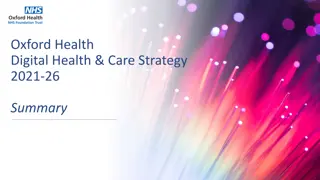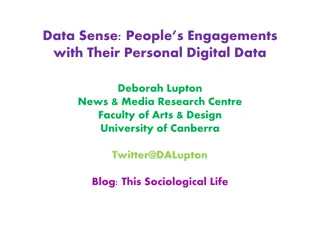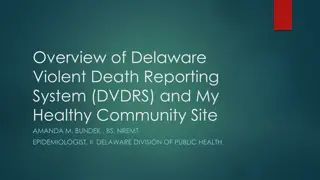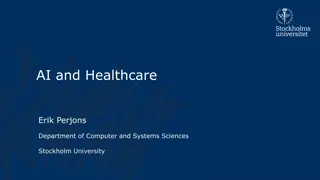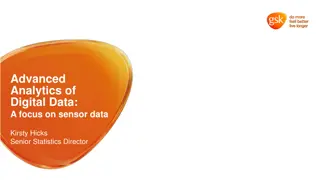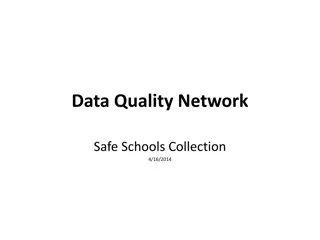Introduction to Utilizing Routinely Collected Digital Healthcare Data
This introduction explores the utilization of routinely collected digital healthcare data for research, evaluation, and quality improvement. It covers data sources, examples of data usage optimization, considerations when working with healthcare data, identification of datasets, and examples of medicines-related data. Additionally, it discusses comfortable analysis methods and includes a quantitative analysis poll.
Download Presentation

Please find below an Image/Link to download the presentation.
The content on the website is provided AS IS for your information and personal use only. It may not be sold, licensed, or shared on other websites without obtaining consent from the author. Download presentation by click this link. If you encounter any issues during the download, it is possible that the publisher has removed the file from their server.
E N D
Presentation Transcript
AN INTRODUCTION TO USING ROUTINELY COLLECTED DIGITAL HEALTHCARE DATA FOR THE PURPOSES OF RESEARCH, EVALUATION OR QUALITY IMPROVEMENT GEMMA DONOVAN ACADEMIC PRACTITIONER, NHS SUNDERLAND CCG & UNIVERSITY OF SUNDERLAND WITH SUPPORT FROM: ADAM RATHBONE ANNA ROBINSON
INTRODUCTION An introduction to using routinely collected digital healthcare data for the purposes of research, evaluation or quality improvement This will include: What data sources may be helpful for medicines-related research Examples of how data can be used and optimised to appropriately answer research questions Things to consider when working with routinely collected healthcare data
WORKSHOP EXERCISE 1 Your research, evaluation or Your research, evaluation or innovation interests innovation interests Routinely collected datasets you Routinely collected datasets you think you have access to think you have access to Write down 5-10 words to describe your research, evaluation or innovation topics you are interested in on one side of the page Now write down all the routinely collected datasets you think you have access to Draw lines to connect where you think these routine data sets align with your interests
WHAT ROUTINELY COLLECTED DATASETS DID YOU IDENTIFY IN THAT EXERCISE? TYPE YOUR ANSWER IN THE TEAMS CHAT
EXAMPLES OF ROUTINELY COLLECTED MEDICINES- RELATED DATA (THAT WE COULD THINK OF) Group messaging channels (e.g.WhatsApp groups) Incident reporting data (e.g. DATIX) Records of meetings (e.g. minutes) Prescribing data (e.g. primary care dispensing data, ePrescribing systems) Service delivery records (e.g. PharmOutcomes) Medical records (e.g. EMIS searches) Patient-generated data (e.g. national questionnaires) National project data (e.g. coordinated audits) Healthcare utilization data (e.g. Hospital Episode Statistics)
Which of the following analysis methods do you feel comfortable with? Start presenting to display the poll results on this slide.
QUANTITATIVE ANALYSIS POLL For the purposes of evaluation, description is usually most useful analysis approach, because: Your dataset may be small (and therefore inferential statistics will be underpowered) It will still help you understand what is happening in your organization Better to triangulate your findings (looking at your research question from multiple sources) than do a more sophisticated analysis on a single dataset If you do want to use more advanced statistical techniques, get some support/ advice (and you should still do the descriptive bits first!)
RAW OR PRE-ANALYSED DATASETS? PRE-ANALYSED DATA Usually anonymized May be pre-integrated with other data Analysis more efficient More easily accessible RAW DATA Confidentiality considerations Can choose integrations with other data Analysis more bespoke Will likely require approvals
EXAMPLE: EVALUATION OF OPIOID REDUCTION IN NHS SUNDERLAND CCG
Can you read a document and do the following? Start presenting to display the poll results on this slide.
QUALITATIVE ANALYSIS POLL Qualitative research helps to explore, conceptualize and understand Excellent for innovative services or new roles and patient or professional experiences research Important to acknowledge the role of the researcher and how this informs the research If you do want to use more advanced analysis to link your findings to theory, get some support/ advice (and you should still do the descriptive bits first!)
WORKSHOP EXERCISE 2 Your research, evaluation or Your research, evaluation or innovation interests innovation interests Routinely collected datasets you Routinely collected datasets you think you have access to think you have access to Go back to your original diagram Can you add more routinely collected datasets? Can you draw more lines between what you are interested in and what data is available?
WRITING RESEARCH QUESTIONS What matters, to whom, and why? Commissioners/ payers Patients/ service users Regulators / governance Stakeholders / interested parties Could they be collaborators in the research question writing process? FINERMAPS (Feasible, Interesting, Novel, Ethical, Relevant, Manageable, Appropriate, Potential value and publishability, Systematic)
WHAT WILL THE DATA ALLOW YOU TO DO? Identify a hypothesised problem or phenomenon Describe or classify a particular issue Deconstruct something to see how it works Identify relationships between things Compare outcomes between different conditions Detect causality
PLANNING A PROJECT USING ROUTINELY COLLECTED HEALTHCARE DATA Research Question Available Data
WORKSHOP EXERCISE 3 Your research, evaluation or Your research, evaluation or innovation interests innovation interests Routinely collected datasets you Routinely collected datasets you think you have access to think you have access to Go back to your original diagram For one of the lines you have drawn, can you have a go at writing one (or more!) potential research questions which you could answer with that data
THINGS TO THINK ABOUT Prioritise suitability over availability Consider the context in which the data was generated in the first place (e.g. payments, purpose of document generation, timing of data generation) Could you actively collect data to complement the use of routinely collected data? (e.g. identify patients who you could then send a questionnaire) Can you improve the quality or utility of the data you are using? (e.g. coding, tags) What ethics or governance approvals do you need?
WHY WE SHOULD DO THIS As a profession, we need to be thinking about evaluating what we do, how we do it, if it works, and why Using routinely collected healthcare data gives us more opportunities than ever before to do this It s power is that it (usually) includes everyone, not just those who opt in It can also allow a process of continuous evaluation and improvement We shouldn t just be providing good quality patient care, we should also be contributing to improving what good quality looks like
GET HELP! Build an evaluation team (consider clinical and methodological experts) Get advice on ethics and governance approvals (see link to research and development team directory in workshop supplement) Speak to someone with experience (Universities, people who have done previous evaluation or research projects) Could this be a funded project? (advice available from the Research Design Service)
ANY QUESTIONS FOR US? Contact us via email Contact us via Twitter Gemma.Donovan@sunderland.ac.uk @AbsoluteGem Adam.Rathbone@Newcastle.ac.uk @AdamPRathbone Anna.Robinson@Newcastle.ac.uk @AnnaRobPharm








